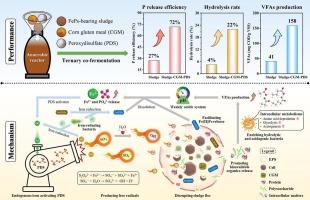内源性铁活化过硫酸氢盐和玉米蛋白粉促进污泥厌氧发酵中磷的释放和酸生成
IF 13.2
1区 工程技术
Q1 ENGINEERING, CHEMICAL
引用次数: 0
摘要
本研究利用含铁磷沉淀物(FePs)的污泥、过硫酸盐(PDS)和玉米麸粉(CGM)开发了一种三元共发酵系统,通过微生物介导的内源铁循环激活 PDS,从而促进磷(P)的释放和酸生成。通过 Fe(III)Ps 生物还原作用产生的 Fe(II)Ps 溶解,Fe(II)与 P 一起释放。随后,释放的铁(II)诱导了 PDS 的活化,从而避免了外部活化剂通过沉淀 P 对 P 释放的负面影响。在此剂量下,P 释放效率从 27.3%(仅污泥组)提高到 71.6%,挥发性脂肪酸(VFAs)产量从 41.0 mg(仅污泥组)提高到 158.5 mg COD/g VSS。通过 PDS 活化产生的 SO4- 和 -OH 分解了污泥絮体,促进了包裹的 Fe(II)Ps 的溶解和有机物的释放。污泥-CGM-PDS 组的可溶性化学需氧量浓度是纯污泥组的 4.4 倍。水解物(如蛋白质类、色氨酸类和酪氨酸类物质)含量的增加和生物降解性的提高,促进了水解产酸菌的富集,使其相对丰度达到 40.7%。未分类___伊格纳维氏菌、梭状芽孢杆菌和 Rubrivivax 是主要的水解产酸生物标志物,它们加强了糖酵解、氨基酸降解和乙酰生成等细胞内代谢,导致 VFAs 产量显著增加。磷酸乙酰转移酶是乙酸酯生物合成的关键酶,其相对丰度增加了 8.9%,从而促进了乙酸生成。此外,未分类的铁还原菌是介导内源铁还原的主要微生物。这项研究为三元共发酵过程中 PDS 的自激活机制和微花特征提供了有价值的见解,有助于含铁污泥废物的价值化。本文章由计算机程序翻译,如有差异,请以英文原文为准。

Enhancing phosphorus release and acidogenesis via endogenous iron-activated peroxydisulfate and corn gluten meal in sludge anaerobic fermentation
In this study, a ternary co-fermentation system was developed using iron-phosphorus precipitates (FePs)-bearing sludge, peroxydisulfate (PDS), and corn gluten meal (CGM) to activate PDS through a microbe-mediated endogenous iron cycle, thereby promoting phosphorus (P) release and acidogenesis. Fe(II) was released along with P via the dissolution of Fe(II)Ps, resulting from Fe(III)Ps bioreduction. Subsequently, the released Fe(II) induced PDS activation, which avoided the negative impact of external activators on P release by precipitation with P. The optimal PDS dosage for ternary co-fermentation was 0.2 mM/g TSS. At this dosage, P release efficiency increased from 27.3 % (sludge-only group) to 71.6 % and volatile fatty acids (VFAs) production increased from 41.0 (sludge-only group) to 158.5 mg COD/g VSS. SO4·− and ·OH generated through PDS activation disintegrated sludge flocs to promote encapsulated Fe(II)Ps dissolution and organics release. The concentration of soluble chemical oxygen demand in the sludge-CGM-PDS group was 4.4 times greater than that in the sludge-only group. The increased content and biodegradability of hydrolysates (e.g., protein-like, tryptophan-like, and tyrosine-like substances) contributed to the enrichment of hydrolytic-acidogenic bacteria, resulting in a relative abundance of 40.7 %. Unclassified_c__Ignavibacteria, Clostridium, and Rubrivivax were the dominant hydrolytic-acidogenic biomarkers, which enhanced the intracellular metabolisms of glycolysis, amino acid degradation, and acetogenesis, leading to notable increases in VFAs yields. The relative abundance of phosphate acetyltransferase, a key enzyme in acetate biosynthesis, increased by 8.9 %, thus facilitating acetogenesis. In addition, unclassified_c__Ignavibacteria, as putative iron reducers, were the primary microbes mediating endogenous iron reduction. This study provides valuable insights into the PDS self-activation mechanism and microfloral traits during ternary co-fermentation, contributing to the valorization of FePs-bearing sludge waste.
求助全文
通过发布文献求助,成功后即可免费获取论文全文。
去求助
来源期刊

Chemical Engineering Journal
工程技术-工程:化工
CiteScore
21.70
自引率
9.30%
发文量
6781
审稿时长
2.4 months
期刊介绍:
The Chemical Engineering Journal is an international research journal that invites contributions of original and novel fundamental research. It aims to provide an international platform for presenting original fundamental research, interpretative reviews, and discussions on new developments in chemical engineering. The journal welcomes papers that describe novel theory and its practical application, as well as those that demonstrate the transfer of techniques from other disciplines. It also welcomes reports on carefully conducted experimental work that is soundly interpreted. The main focus of the journal is on original and rigorous research results that have broad significance. The Catalysis section within the Chemical Engineering Journal focuses specifically on Experimental and Theoretical studies in the fields of heterogeneous catalysis, molecular catalysis, and biocatalysis. These studies have industrial impact on various sectors such as chemicals, energy, materials, foods, healthcare, and environmental protection.
 求助内容:
求助内容: 应助结果提醒方式:
应助结果提醒方式:


